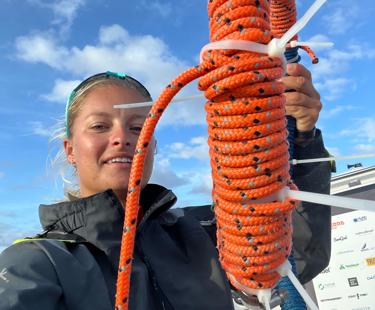As Miriam and Jess continue their incredible 8,000-mile odyssey across the Pacific Ocean, the cutting-edge equipment they rely on plays a vital role in ensuring their safety, efficiency, and communication during this epic voyage. Many of the features that make this gear indispensable are, or were, protected by patents, the unsung heroes behind these technological marvels.
In this series of articles, we delve into several key pieces of equipment the "Seas the Day" team relies on. While some items are used every day and others only in an emergency, the watermaker is arguably the most critical piece of equipment on the boat. Let's delve into its history and the recent innovations that make it so indispensable.
Advanced Engineering for Survival: The Watermaker
Imagine rowing thousands of miles across the vast Pacific Ocean, relying solely on your own strength and a small boat. One of the most critical elements for survival is fresh water. The "Seas the Day" crew faces this challenge head-on, thanks to an ingenious piece of technology: the watermaker. But how did this essential device evolve to withstand the harsh realities of ocean rowing, and what role has intellectual property played in its development?
Ocean rowing is a brutal test of human endurance and equipment reliability. The "Seas the Day" team needs a constant supply of potable water, not just for hydration, but for cooking and hygiene. Traditional water storage is impractical due to immense space and weight limitations. This is precisely where the on-board watermaker becomes indispensable.
The Evolution of Reverse Osmosis: From Lab to Ocean
The heart of the watermaker is reverse osmosis (RO), a process pioneered by Sidney Loeb and Srinivasa Sourirajan in the 1960s. Their ground-breaking work laid the foundation for modern water purification. However, ocean rowing demands more than just basic RO; it requires robust, energy-efficient, and highly reliable systems. Recent innovations, often safeguarded by patents, have significantly advanced watermaker technology, focusing on several key areas. This includes the development of more efficient and durable membranes, capable of enhanced filtration and reduced fouling, sometimes incorporating nanomaterials. Energy recovery systems have become standard, capturing and reusing pressure from the brine stream to dramatically cut power consumption, a critical factor for off-grid vessels.
Furthermore, modern watermakers feature automated monitoring and control, increasingly integrating AI for optimized performance and predictive maintenance. The physical designs have also evolved, resulting in compact, robust units that fit into confined spaces, while power source flexibility, including optimized solar and battery integration, ensures reliable operation in challenging marine environments.
The Indispensable Role of Intellectual Property
The journey of reverse osmosis (RO) watermakers, from laboratory concept to indispensable survival gear on expeditions like the "Seas the Day" odyssey, is deeply intertwined with patent protection. Pioneering work by Sidney Loeb and Srinivasa Sourirajan in the 1960s, with patents like US3133132A for "High flow porous membranes for separating water from saline solutions," laid the foundational groundwork for practical RO by developing effective semi-permeable membranes.
Subsequent innovations, often spurred by the exclusive rights granted by patents, have dramatically refined these systems. For instance, the US Patent 4,434,056 by Bowie G. Keefer exemplifies advancements in the multi-cylinder pump apparatus and method, crucial for efficient operation. Beyond core mechanics, patents now cover a wide array of improvements: from next-generation membrane materials with enhanced efficiency and fouling resistance (e.g., US4039440A for "Reverse osmosis membrane" improvements), to sophisticated energy recovery systems (like those seen in US6491813B2 by Schenker for "Equipment for desalination of water by reverse osmosis with energy recovery") that significantly reduce power consumption, and even intelligent automated monitoring and control software. This continuous cycle of innovation, incentivized by intellectual property, ensures that robust and reliable watermakers continue to evolve, making extraordinary feats of endurance, such as rowing across the Pacific, increasingly feasible.
Crew Experience
 For Miriam and Jess, the ability to produce fresh water on demand not only sustains them physically but is also a tremendous boost to their morale, a constant reminder of the ingenuity that underpins their ambitious endeavour.
For Miriam and Jess, the ability to produce fresh water on demand not only sustains them physically but is also a tremendous boost to their morale, a constant reminder of the ingenuity that underpins their ambitious endeavour.
Their journey, however, has presented significant challenges to their vital equipment. Due to frustrating power issues with their batteries and extensive cloud cover, their main electrical watermaker has been inoperable at times, forcing reliance on their emergency manual hand pump. During recent use, the manual pump's intake filter and weight broke off, leaving the team in a difficult spot. Demonstrating ingenious creativity, they fashioned a new intake filter using the stretchy material of a pair of Miriam’s underwear and a carabiner for weight, successfully restoring the hand pump's functionality.
This repair was crucial, especially since they've also discovered that some of the electrical watermaker's pipes were not rated for the required pressure, leading to recurring bursts (they are currently on repair number 7). Given the fragility of the electrical watermaker pipes and still having 4,000 miles to go, not being able to fix their manual watermaker could have meant the potential end of their non-stop and unsupported row attempt.
As they push through these challenges, the efficiency and reliability of their watermaker, affectionately nicknamed 'Salty', become even more critical. This vital piece of equipment has truly been put through its paces, with Jess and Miriam having to patch up its pipes on several occasions, really highlighting the immense strength of the ocean and the relentless demands it places on their gear.
Their journey is a testament to the power of innovation and the vital importance of intellectual property in bringing life-saving and journey-enabling technologies to the most challenging environments on Earth.
Follow the "Seas the Day" challenge to support Miriam and Jess's mission and learn more about the remarkable technology that powers their journey and the patents that have made it all possible.

